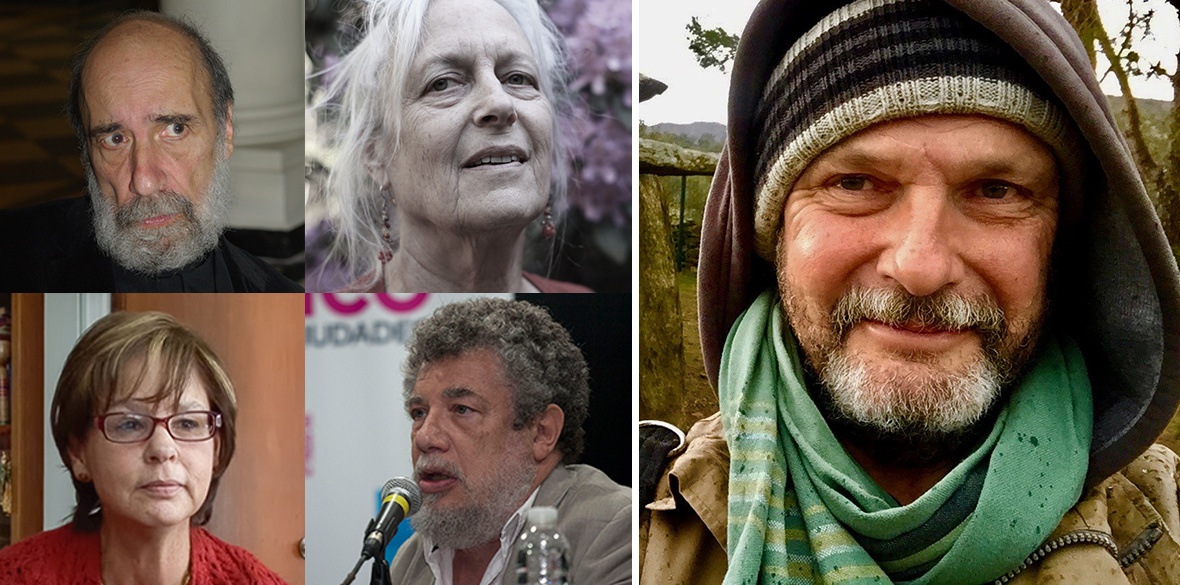This is the last article you can read this month
You can read more article this month
You can read more articles this month
Sorry your limit is up for this month
Reset on:
Please help support the Morning Star by subscribing here
“WHEN I was 15, I read all of Che Guevara’s works,” says Richard Gwyn. “So, when I went to university, I was particularly interested in the anthropology of certain Latin American communities… There was a mix of different influences. Discovering Gabriel Garcia Marquez, of course, and Jorge Luis Borges… These things all contributed to a kind of fascination, which was slightly dreamy, based on ideas I didn't fully comprehend.”
That’s how Gwyn began his interest in Latin America as a student, leading him many years later to travel to that vast region in search of poets for a landmark anthology.
A first visit to the International Poetry Festival in Granada, Nicaragua, convinced him of the need to produce an anthology of recent poetry from Latin America, which eventually became The Other Tiger (Seren, 2016).
His most recent book, Ambassador of Nowhere: A Latin American Pilgrimage (Seren, 2024), reads like a sequel to the anthology, taking the reader on a fascinating journey to five countries: Nicaragua, Argentina, Uruguay, Mexico, Colombia and Chile.
His travels became a quest for self-discovery, the record of personal loss, and the making of deep friendships through poetry. It also provided a platform to explore those vast countries, their people, histories, tragedies and complexities.
Gwyn describes meetings with fellow poets, such as Julian Herbert, in Saltillo, a sleepy village in Mexico. Both writers drink in bars and discuss poetry, politics and life.
“Although we had very different backgrounds we discovered we had a lot in common, and this went on from staying with him and then returning to Mexico City and the hospitality that I received from Pedro Serrano and other poets. It was replicated in the other countries I went to. This network of poets and writers just knocked me off my feet because people were so generous with their time and hospitality.”
As he explains in his book, through these friendships he gathered some of the most compelling poems for his anthology, exploring themes of homeland, belonging, activism, violence and political struggles, among others.
“Over the course of my travels in Mexico and Colombia, I encountered many stories of the most heartbreaking kind, and although I never set out to chronicle mind-numbing horrors of this kind for their own sake and have no interest in leaving behind a litany of desperate sorrows, I have begun to understand that what happens to one abducted child in Mexico happens not only to that child but to all children, everywhere.”
He included the poem The Dead by Mexican Maria Rivera, translated by Gwyn, dealing with violence in that country, that ends with the lines: “Francisco (53)/ gagged in the scrubland,/ hands tied/ in the gardens of ranches,/ vanished/ in the gardens of ‘safe houses’,/ in some forgotten wilderness,/ disintegrating mutely/ and in secret,/ they are called/ secrets of hitmen,/ secrets of slaughter,/ secrets of policemen.”
In his book, Gwyn also writes about poetry translation and dedicates a chapter to Alastair Reid, the long-time translator of Borges and many other Latin American literary giants, whom he met in Scotland months before Reid’s death in September 2014.
“The first works of Borges that I read were, of course, not by Borges; they were by Alastair Reid. So that was my introduction.”
He also mentioned Edith Grossman, the translator par excellence of Spanish into English in the 20th Century, as his “biggest influence.” “Her ideas about translation are so lucid and so correct that she says, you don’t make stuff up; you don’t deviate from the core essence of the original work. That’s for cowboys.”
Gwyn translated many poets for his anthology, including Argentinians Daniel Samoilovich and Laura Wittner, Chileans Veronica Zondek and Raul Zurita, Mexicans Fabio Morabito and Julian Herbert, and Colombians Dario Jaramillo and Piedad Bonnett, to name but a few. But how was his translation process from such varied authors from many countries, histories and personal journeys?
“My principle was, if in trouble, I’d ask. I’d always ask a native speaker from that country for advice on particular formulations that I found unfamiliar because I had made close friends in those countries. It wasn’t difficult to get advice, and of course, I also was in communication with many of the poets themselves about their work and they’re usually very willing to talk about it. I loved working with the different varieties of language.”
Gwyn also discusses the sections in his anthology, loosely called “Where we live,” “Where we come from,” “The world we share,” “What we do and where we go,” “What we are and how we love,” and “What becomes of us.”
“The themes in The Other Tiger emerged because those were the themes I found most commonly addressed. So, if I were to say that, then what is the overall thematic direction of Latin American poetry? It would be impossible to answer, but these were the things I noticed. And I think that for three-quarters of the way, I was led by the poems themselves. It was a kind of evolutionary process,” he adds.
Gwyn says the choices were guided by personal political inclinations and his literary inclinations. “I have a weakness, perhaps, for the more narrative type of poem. And strong on imagery and certain traditional aspects of the poem. So, there isn’t much representation of ultra-modernist, concrete poetry or some equivalents in the anthology. In that way, it's fairly conservative, I suppose. But then the poems they included were, to a large degree, the poems I liked.”
Among my favourites are refined poems by Mexican Coral Bracho, Argentinian Beatriz Vignoli and Dominican Frank Baez.
The anthology and the accompanying travel book inform and enrich each other, giving glimpses of Gwyn himself as a poet and writer, about his life, personal struggles, and a family loss when his father died in south Wales, that closes the book.
“An outer journey is always an inner journey. The two reflect each other. It’s almost as if those circles closed, and that era ended. Since 2011, I’ve been blogging under the name Ricardo Blanco, a translation from my name in Welsh. I decided a couple of weeks ago to finish him off. My blog is no longer called Ricardo Blanco but Richard Gwyn. It feels like a circle has been closed after all these years.”
Gwyn’s latest book is a fascinating and multilayered enterprise. It intersperses the personal with the literary, the political with the social, and takes the reader through multiple landscapes and discoveries.
“A lot has to do with serendipity and things happening at a certain time. And I think the whole book is based on that principle. Serendipity and happenstance and synchronicity.”










